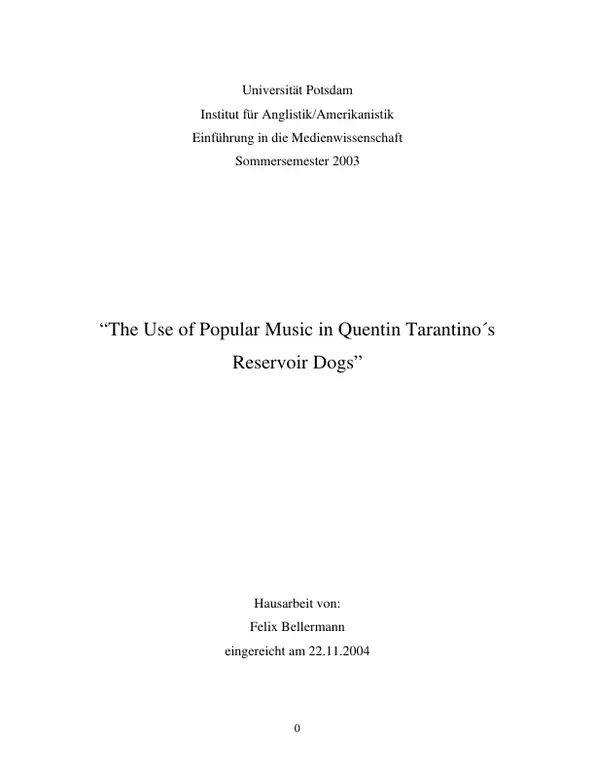Qurntin Tarantino´s movies are mostly violent scenarios in the world of American West-Coast gangster bosses and their Hit-Men - Shoot-outs, language as brutal as the action and even cooler quotations.
Almost all of his movies have managed to be at least cult among the younger generations. Is the type of music Tarantino uses in most his films responsible for their popularity, since it is mostly popular music? If it is, what exactly is the effect of the music that Tarantino uses?
One may certainly say that in his movies film and music represent two different types of media: There are no movie-themes involved which have been composed only for this purpose.
As a regisseur, Tarantino prefers "chewing gum" music as he calls it, which contrasts the scenes taking place on the screen (Havighorst, Michaltsi, Strauß).
Tarantino´s songs have has an “own life” in the real world of the watchers, apart from the movie. The most famous example is probably the “Pulp Fiction”- soundtrack-album, which in is, in certain circles, mostly of the female gender, even more popular than the movie itself.
Anyway, it seems obvious that Tarantino has a specific style of combining the accoustic and the visual media in his works. I want to find out possible results and intentions of this more or less unique combination.
Inhaltsverzeichnis (Table of Contents)
- Contents
- Introduction
- Why Quentin Tarantino?
- Definition of Popular Music
- The Procedure
- Song Analysis
- General Observations
- The songs
- “Little Green Bag”
- “I gotcha”
- “Stuck in the middle with you”
- Conclusion: The Meaning and Function of Music for Tarantino
- Bibliography
Zielsetzung und Themenschwerpunkte (Objectives and Key Themes)
The main objective of this paper is to examine the use of popular music in Quentin Tarantino’s film “Reservoir Dogs”. The author aims to analyze the relationship between the musical choices and the film’s narrative, emotional impact, and overall aesthetic.
- The significance of popular music in shaping the film's aesthetic and tone.
- The interplay between music and action in enhancing the emotional impact of scenes.
- The analysis of specific songs, their lyrics, and their relationship to the film's narrative.
- The influence of Tarantino's music choices on the film's overall message and meaning.
- The impact of Tarantino’s music choices on the film’s popularity and reception.
Zusammenfassung der Kapitel (Chapter Summaries)
The introduction establishes the context for the analysis, highlighting Tarantino’s cinematic style and the prominence of popular music in his films. The author argues that the specific music choices have a significant impact on the film’s reception and popularity. The paper aims to explore the interplay between the visual and the acoustic in Tarantino's work.
The second chapter delves into the definition of popular music, exploring its broad scope and its significance as a medium of mass consumption.
The third chapter outlines the methodology employed for the analysis. This includes a three-stage viewing process to observe the film from different perspectives and identify the relationship between music and action. The author also outlines four key aspects for analyzing the function of popular music in film: lyrics, sound, context, and secondary connotations.
Chapter four provides an overview of the chosen songs for analysis, with a brief description of their lyrical content, musical character, and emotional impact. The author specifically focuses on “Little Green Bag,” “I gotcha,” and “Stuck in the middle with you.”
Schlüsselwörter (Keywords)
Popular music, film analysis, Quentin Tarantino, “Reservoir Dogs,” soundtrack, aesthetic, emotional impact, narrative, secondary connotations, lyrics, sound, context.
- Quote paper
- Felix Bellermann (Author), 2004, The use of popular music in Quentin Tarantinos 'Reservoir Dogs ', Munich, GRIN Verlag, https://www.hausarbeiten.de/document/73161


